
2015 | OriginalPaper | Buchkapitel
1. Euclidean and Minkowski Steiner Trees
verfasst von : Marcus Brazil, Martin Zachariasen
Erschienen in: Optimal Interconnection Trees in the Plane
Aktivieren Sie unsere intelligente Suche, um passende Fachinhalte oder Patente zu finden.
Wählen Sie Textabschnitte aus um mit Künstlicher Intelligenz passenden Patente zu finden. powered by
Markieren Sie Textabschnitte, um KI-gestützt weitere passende Inhalte zu finden. powered by